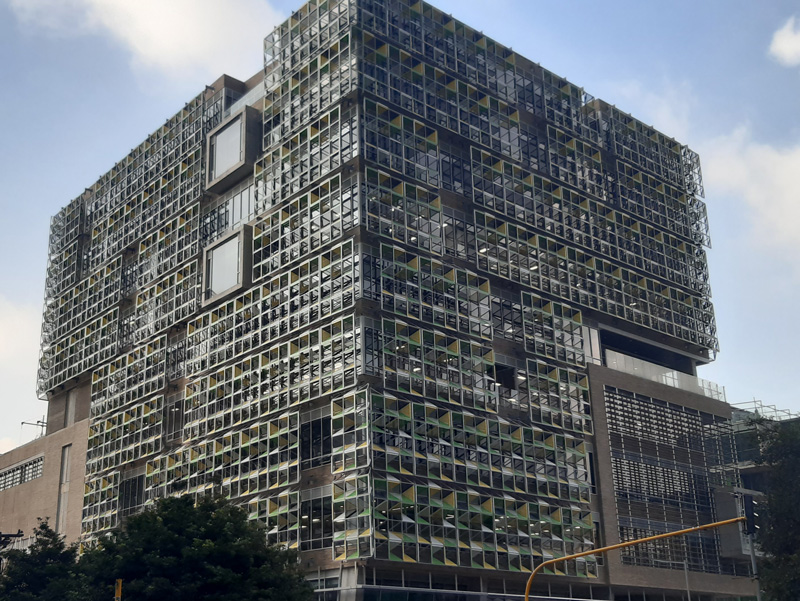 9 min
9 min
The Colombian city of Cali is hosting the UN’s 16th World Conference on Biological Diversity (COP16) on the theme of “Making or being at peace with Nature”, an opportunity to interview Colombian architect Agustín Adarve Gómez, a pioneer of bioclimatic architecture and sustainability. His firm “Natural Cooling” has been developing natural cooling systems since 1980, and has completed more than thirty projects worldwide certified by the US Green Building Council. With more than 40 years’ experience in the research, design and application of advanced natural air-conditioning systems and the use of solar and wind energy, he is calling for an overhaul of architectural practices.
What convinced you to devote yourself to bioclimatic architecture more than 40 years ago, and how do you define it?
I wanted to provide solutions for the poorest families, with no access to air conditioning or drinking water, and to develop architecture adapted to countries with tropical climates like my own, Colombia.
When I was still a student, I designed a project for the fishing village of Punta Canoa near Cartagena [a city on the north coast of Colombia], which met the need for cooling by using natural ventilation systems. The houses were built using local resources – earth blocks, straw – and the wind and vegetation provided cooling and shade. And a solar-powered still generated drinking water. At the time, however, I had to fight hard to make people understand that we must resort to solutions other than air conditioning.
Bioclimatic architecture aims to provide comfort and well-being. It relies on the use of natural ventilation and the maximization of natural lighting. It uses thermal inertia and optimization of the building orientation to take advantage of solar energy. With natural ventilation systems, which can also be combined with air conditioning but on a much smaller scale than with conventional systems, a building’s energy requirements can be reduced by up to 30%, significantly lowering costs for the end-user while improving well-being. The return on investment comes after no more than five years, bringing significant benefits to both financial investors and users.
Up to 30% energy savings through natural building ventilation.
You say that buildings can provide comfort and well-being. Does this require an overhaul of traditional architectural practices?
With global temperatures set to rise by more than 2°C, architectural practices will have to be overhauled. New energy demands and a new concept of comfort will have to be incorporated as the climate changes. Buildings should be more than giant glazed blocks running on air conditioning.
The theme of bioclimatic architecture has been extensively documented with vernacular architecture [designed in keeping with its region], the alternative movements of the 1970s, the ecological movement of the 1980s and the energy-efficient buildings of the early 21st century. Today, the challenge of global warming requires us all to engage in responsible bioclimatic design, namely applied, rigorous, with real, innovative and above all reproducible results for the benefit of future generations. Previously, as with Le Corbusier, we depended on the genius of a single architect. Now, we need to promote collaboration between construction stakeholders through an iterative process. The very design of buildings must take into account the interactions between all these stakeholders, in order to achieve the most efficient solutions.
Through the application of bioclimatic architecture, buildings can become more than just a roof or a shelter, more than just a component that forms part of the landscape or the space we share. They can breathe, protect, illuminate, produce and provide comfort and well-being. To achieve this, they need to be fitted with a suitable skin that reduces solar gain while producing energy, by incorporating photovoltaic panels for example.
It should be noted that green buildings can be used to obtain carbon credits from financial institutions, with the associated tax benefits that brings. Furthermore, the additional investment required to ensure the sustainability of a building – for example, by choosing high-performance glazing that is more expensive but much more efficient than conventional glazing – can be recouped, as these buildings will generate energy savings throughout their lifetime.
Your country, Colombia, is hosting the UN biodiversity summit COP16, in Cali from October 21 to November 1, 2024. Do you think the construction sector can play a leading role in the coming years in taking greater account of the living world? And if so, making what kind of progress?
With an exceptional diversity of species and ecosystems, from the Andes to the Amazon (birds, plants, orchids, butterflies, freshwater fish and amphibians), Colombia is committed to sustainability and the protection of biodiversity, notably with the support of the Colombian Council for Sustainable Construction (CCCS), of which I am a member. Tax incentives are in place to encourage green buildings.
The construction sector can indeed help to better incorporate the living world. Building facades must not pose a danger to birds: indeed, LEED certification is not possible if the glazing is so mirror-like that birds risk crashing into it.
We can combat heat islands while preserving biodiversity by introducing green roofs, landscaping and parks in the heart of cities. On a green roof, insects can set up home, and bees can come to forage. Conversely, asphalt-based roofs generate enormous overheating, and bees, for example, are highly sensitive to solar radiation. Green roofs also enable rainwater to be harvested and treated, reducing the risk of flooding and air pollution. Similarly, the creation of urban parks encourages the return of nature to the city and the conservation of biodiversity. And leaving plenty of room for vegetation also helps capture CO2.
Which cities would you say are the most exemplary in terms of respect for flora and fauna?
The city of Cali in south-western Colombia, where COP16 is taking place, is an extraordinary city with rich biodiversity. The botanical garden in Cali is a real sanctuary, and exemplary in terms of flora and fauna conservation. In particular, Cali has developed systems for recovering water from riverbanks and shorelines, and it has promoted waste treatment.
In Brazil, the city of Curitiba is also following an exemplary urban development approach, ensuring a balance between buildings and vegetation. The city has no fewer than 48 parks and 13 million m2 of natural vegetation, with green spaces representing 60 m2 per inhabitant (five times more than the minimum recommended by the World Health Organization). Public transport is particularly well developed, with over 300 bus routes running on biodiesel since 2010 and covering more than 1,000 km, reducing pollution from cars.
In Australia, in both Melbourne and Sidney, the construction industry, as documented by Passive and Low Energy Architecture (PLEA), has supported the development of sustainable urban planning, in particular through the use of local tree species to reduce heat island effects.
For its part, the US Green Building Council has launched “LEED for Cities and Communities” certification, which aims to help local leaders create and implement responsible and specific energy, water, waste and transport management plans, to reinvent the way cities and communities are planned, developed and operated with the aim of improving sustainability and quality of life.
What role can architects play in greener urban development?
Architects can play an integrating role by making sustainability the basis of all design. For too long, architects have focused on beauty and aesthetics. A paradigm shift is needed. Architecture needs to be more flexible, more sustainable. The design of the building envelope needs to be carefully thought through, with selection of environmentally friendly materials. Thermal solutions should be carefully studied, with a preference for natural ventilation. In this way, a tower can be designed to evacuate heat easily through the chimney effect, with the indoor spaces optimized through use of natural lighting. It is also important to strike a balance between glazing and insulation. Beauty must be the result of sustainability..
How can these challenges be reconciled with other urgent issues, such as access to decent housing for all?
Bioclimatic architecture can be applied in different areas, to commercial buildings, institutional buildings and housing. Sustainable housing is socially beneficial for everyone. Building social housing that offers quality of life and space is not necessarily more expensive, especially given that banks can often cross-subsidize its construction.
I designed and built social housing in a remote tropical village called Utica, which had been destroyed by a landslide. I was able to cut costs significantly, by avoiding thermal insulation and just using very simple metal sheets adapted to the humid tropical climate. Bioclimatic architecture makes it possible to provide low-income residents with housing that is better suited to their needs because it is better ventilated. This was a very satisfying project that once again gave me the opportunity to turn my student dreams into reality.
The example highlighted by Agustín Adarve GómezArchitectural firm Natural Cooling provided American architect and designer William Mc Donough with technical support for the headquarters of the EAN University in Bogotá. The building comprises a dynamic double-skin facade and thermostatic towers made of plexiglass tubes and passive solar skylights. As such, the project combines passive ventilation and solar control systems, integrated with air injection. The tower’s avant-garde design maximizes energy savings in classrooms, communal areas and the sports center.

To go further, read the book by Agustín Adarve Gómez: Bioclimatic architecture, a life experience
Photo credits: © William McDonough + Partners







